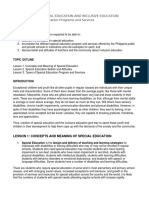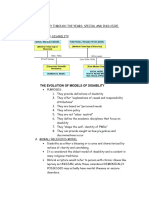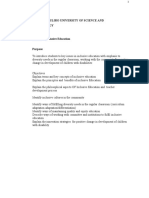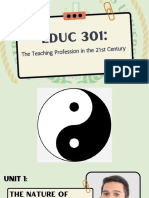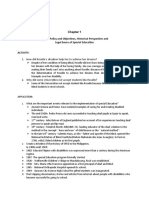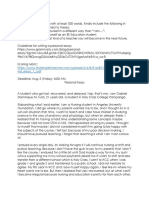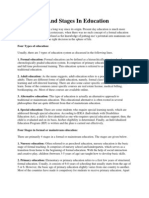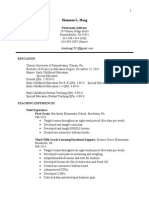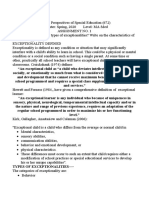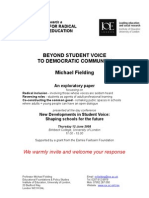Prelim Module 3
Prelim Module 3
Uploaded by
Dominique TurlaCopyright:
Available Formats
Prelim Module 3
Prelim Module 3
Uploaded by
Dominique TurlaOriginal Description:
Original Title
Copyright
Available Formats
Share this document
Did you find this document useful?
Is this content inappropriate?
Copyright:
Available Formats
Prelim Module 3
Prelim Module 3
Uploaded by
Dominique TurlaCopyright:
Available Formats
FOUNDATION OF SPECIAL AND INCLUSIVE EDUCATION
Week 3:
Class discussion
Answer the following questions:
What is the meaning of IDEA?
What are the terminologies used in studying Special and Inclusive
Education?
What will students learn from this topic?
• Understand the reasons behind IDEA
• Familiarize themselves with the terminologies used in teaching Inclusive and special
Education
What is IDEA?
It is a part of an overall strategy designed to deliver needed services appropriate to the
individual preschooler and toddler students.
A reauthorization of Public Law 94-142 which is known as the “Education for All
Handicapped Children Act”.
Why replaced “handicapped children” to “individuals with disabilities”?
*IDEA guaranteed all children and youth regardless of the severity of their disability to free
and appropriate public education.
*Focused on both early childhood special education and the transitional needs of the
individuals with disabilities.
1990 Individuals with Disabilities Education Act (IDEA) (Public Law 101-476)
Renames and replaces R L. 94-142 (E HC )
Establishes "people first" language for referring to people with disabilities
Extends special education services to include social work and rehabilitation services
Extends provisions for due process and confidentiality for students and parents
Adds two new categories of disability autism and traumatic brain injury
Requires states to provide bilingual education programs for students with disabilities
Requires states to educate students with disabilities for transition to employment, and
to provide transition services
Requires that all students with disabilities must continue to receive services, even if
they have been expelled from school
Allows states to extend their use of the developmental delay category for students
through age 9
AUTHORED BY: PABLITO P. GANTAN JR., LPT, Ed.D.
FOUNDATION OF SPECIAL AND INCLUSIVE EDUCATION
Requires schools to assume greater responsibility for ensuring that students with
disabilities have access to the general education curriculum
Allows special education staff who are working in the mainstream to assist general
education students when needed
Requires a general education teacher to be a member of the IEP team
Requires students with Disabilities to take part in state- and district-wide
assessments
(Taken from google images)
TERMINLOGIES USED IN SPECIAL EDUCATION
These are the proper use of language in dealing with persons with special needs:
AUTHORED BY: PABLITO P. GANTAN JR., LPT, Ed.D.
FOUNDATION OF SPECIAL AND INCLUSIVE EDUCATION
The following are the terms used in the study of Special and Inclusive Education
A. Individualized Instruction – the child’s characteristics rather than the prescribed
academic content provide the basis for teaching techniques.
A. Intervention is a general name for all efforts in behalf of individuals with disabilities
B. Remedial Programs
Remediation and rehabilitation- Teaching a person with disabilities basic skills for
independence – may be academic or even personal also thru Vocational
rehabilitation
D. Compensatory Efforts
- Giving a kind of substitute skill or device to rely on to compensate for a person’s
disability
- Aims to give an individual asset to be able to use tools and techniques for meeting
learning needs
E. Exceptional students include both the handicapped and the gifted children.
Exceptional child refers to the child who deviates from the average or normal child in:
- Mental characteristics
- Sensory abilities
- Neuromuscular or physical characteristics
- Social or emotional behavior
- Communication abilities
- Multiple handicaps to such an extent that he requires modification of
school practices, or special educational services, to develop to his maximum
capacity.
F. Disability – refers to the reduced function or loss of a body part or organ. It is
sometimes used
interchangeably with the term impairment.
G. Handicap – refers to a problem with disability or impairment encounters in
interacting with the environment. A disability may pose a handicap in one
environment but not in another
H. At risk – refers to children who, although not currently identified as having a
disability, are considered to have greater-than-usual chance of developing a
disability.
I. Labeling implies more than simply identifying children who need special
education services.
AUTHORED BY: PABLITO P. GANTAN JR., LPT, Ed.D.
FOUNDATION OF SPECIAL AND INCLUSIVE EDUCATION
Labeling has been viewed as demeaning, stigmatizing, and discriminatory,
especially with regard to the potential to exclude children based on poverty or
membership in ethnic and culturally diverse groups.
Those with disabilities were prevented full participation in the activities in the
community.
J. Normal- is someone who conforms to the ideals of society. This can be for any
number of reasons, ranging from the positive (genuine admiration for and
acceptance of society's standard, for example) to the negative (fear of
humiliation, fear of rejection, fear of being thought mad).
K. Abnormal- is subjectively defined characteristic, assigned to those with rare or
dysfunctional conditions.
Performance Task 2: Comparative Analysis on DepEd Order 21 series 2019 and IDEA
Performance Standards
Content 50%
Originality 25%
Timeliness 25%
Total 100
AUTHORED BY: PABLITO P. GANTAN JR., LPT, Ed.D.
FOUNDATION OF SPECIAL AND INCLUSIVE EDUCATION
List of References:
Accardo, P. & Whitman, B. (1997). Dictionary of developmental disabilities terminology.
Sydney: MacLennan & Petty
Behan, Dawn. (2015). Taking sides: clashing views in special education.
Bowden, W. & Bowden, J. (Undated). Me too…the child with special needs in the regular
classroom. Callan Services, PNG.
Convention on the Rights of the Child UN Standard Rules on the Equalization of
Opportunities for persons with Disabilities 1993
Christensen, C. A., (1992). Social justice and the construction of disability in schools
Australian Association of Special Education Newsletter, 3, 6-8. Cited in Dempsey, I.
Principles and policies for integration and inclusion, in Foreman, P. (Ed.). (2001). Integration
and inclusion in action. Sydney: Harcourt.
Dakar Framework for Action 2000 Millenium Development Goal2. Universal primary
Education by 2015
DepEd Inclusive Education Policy Framework Differentiation and Enrichment Strategies for
Gifted Students
Department of Education (1993). National special education plan and policy and guidelines
for special education. PNG Government publication.
EFA Fast Track Initiative 2002 UN Convention on the Rights of Persons with Disabilities
Escowitz S. (n.d.) Multiple Disabilities in Your Classroom: 10 Tips for Teachers . The Special
Ed Wiki. Sped.wikidot.com/emotional-behavioral disorder-disorders.
Fliess, S. D. (n.d.) Twice exceptional children .
http://www.education.com/magazine/article/Ed_Twice_Exceptional/?page=2
Foreman, P. (2000). Disability, integration and inclusion: Introductory concepts. In P. Foreman
(Ed.), Integration and inclusion in action (2nd ed.). Sydney: Harcourt
Foreman, P. (2001). Disability, integration and inclusion: Introductory concepts. In Foreman,
P. (Ed.). Integration and inclusion in action. 2nd edition. Sydney: Harcourt.
Gargiulo, Richard M. (2015).
Griffin, (2015). Handbook of Learning Disabilities .
Imray, Peter. (2013). Curricula for Teaching Children and Young people with severe or
profound and multiple learning disabilities
Kelley, P. & Gale, G. (1998). Towards excellence: Effective education for students with
vision impairments. Sydney: Royal Institute for Deaf and Blind Children
Lansingh, V. & Buzolic, G. (2000). Eyes. Wewak: Callan Services
AUTHORED BY: PABLITO P. GANTAN JR., LPT, Ed.D.
FOUNDATION OF SPECIAL AND INCLUSIVE EDUCATION
McGraw-Hill. Clark, B. (2010). Characteristics of gifted children with disabilities, excerpt from
Growing Up Gif ted: Developing the Potential of Children at Home and at School . 2008 ed,
p.362-364.
National Department of Education, Papua New Guinea. (1993). National special education
plan and policy and guidelines for special education.
Nirje, B. (1970). The normalization principle: Implications and comments. British Journal of
Mental Subnormality, 16, 62-70.
Special Education in Contemporary Society: An Introduction to Exceptionality . Los Angeles:
SAGE Publications.
Salend, S. & Duhaney, G. (1999). The impact of inclusion on students with and without
disabilities and their educators. Remedial and SpecialEducation, 20 (2).
Saunders, C. & Miles, S. (1990, updated 2001). The uses and abuses of surveys in service
development and planning for disabled people: The case of Lesotho. Enabling Education
Network at www.eenet.org.uk
Rule 6 UNESCO- Salamanca Statement and Framework for Action 1994 Education for All
World Forum,
PNRTCQ Prototype Syllabus
PNG Department of Education (1998). Special education: Teachers resource book. Trial
edition.
PNG Department of Education (1993). National special education plan and policy and
guidelines for special education
PNG Department of Education (1993). National special education plan and policy and
guidelines for special education.
The Guilford Press.(D)
Vaughn, S., Bos, C. & Schumm, J. (2000). Teaching exceptional, diverse and at-risk
students in the general education classroom. Boston: Allyn & Bacon Practical classroom-
based advice
Vaughn, S., Bos, C. & Schumm, J. (2000). Teaching Exceptional, Diverse and At-Risk
Students in the General Classroom. Boston: Allyn & Bacon)
Werner, D. (1987). Disabled village children. Palo Alto: Hesperian Foundation.
Westwood, P. (1997). Commonsense methods for children with special needs. London:
Routledge Falmer.
Wright, J. & Kersner, M. (1998). Supporting children with communication problems. London:
Fulton
AUTHORED BY: PABLITO P. GANTAN JR., LPT, Ed.D.
FOUNDATION OF SPECIAL AND INCLUSIVE EDUCATION
Werner, D. (1987) Disabled village children. Palo Alto: Hesperian Foundation Good practical
information, mainly about identification, rehabilitation, prevention, and medical therapy
World Health Organization (1980). International classification of impairments, disabilities, and
handicaps. Geneva: WHO
AUTHORED BY: PABLITO P. GANTAN JR., LPT, Ed.D.
You might also like
- Learning Theories Venn Diagram 1Document1 pageLearning Theories Venn Diagram 1api-489318508No ratings yet
- Course Title Course Code Number of UnitsDocument6 pagesCourse Title Course Code Number of UnitsMingNo ratings yet
- CHAPTER 2 - Lesson 1 - 3Document13 pagesCHAPTER 2 - Lesson 1 - 3Jan Aries Manipon100% (1)
- notes-SPED 307 Continuum of ServicesDocument30 pagesnotes-SPED 307 Continuum of Servicesshai gestNo ratings yet
- Module 6 Prof Ed 103Document4 pagesModule 6 Prof Ed 103Gigi Man100% (1)
- Module in in Foundation of Special and Inclusive EducationDocument13 pagesModule in in Foundation of Special and Inclusive EducationCatherine GauranoNo ratings yet
- The 10 Themes of Social StudiesDocument3 pagesThe 10 Themes of Social StudiesRoanne Melissa Llarena Urrea100% (1)
- Addressing Diversity Through The Years Special and Inclusive EducationDocument6 pagesAddressing Diversity Through The Years Special and Inclusive EducationJiezel SurinNo ratings yet
- Lecture Lesson 3Document4 pagesLecture Lesson 3Althea May M. ALINEANo ratings yet
- Learners Who Are Gifted and Talented: Lesson 01Document11 pagesLearners Who Are Gifted and Talented: Lesson 01QuinChiNo ratings yet
- History Legal Bases of SPED PDFDocument34 pagesHistory Legal Bases of SPED PDFAngelica MarinNo ratings yet
- Introduction To Special and Inclusive EducationDocument9 pagesIntroduction To Special and Inclusive EducationJustin Paul Vallinan100% (1)
- Davao Oriental State College of Science and Technology: SyllabusDocument10 pagesDavao Oriental State College of Science and Technology: SyllabusElla KiayNo ratings yet
- Final Coverage Foundations of Special and Inclusive EducationDocument28 pagesFinal Coverage Foundations of Special and Inclusive EducationSheena LiagaoNo ratings yet
- Eps 402 Notes-1Document35 pagesEps 402 Notes-1Jared MutindaNo ratings yet
- Foundation of Special and Inclusive EducationDocument7 pagesFoundation of Special and Inclusive EducationShirley CaboralNo ratings yet
- Chapter 4 Components of Special and Inclusive EducationDocument23 pagesChapter 4 Components of Special and Inclusive EducationDe Vera Thristan Blue100% (1)
- Group 4 - HandoutDocument17 pagesGroup 4 - HandoutKyle Justin Rayos100% (1)
- Unit 7:: Professionalism and Transformative EducationDocument24 pagesUnit 7:: Professionalism and Transformative EducationRobert C. Barawid Jr.100% (1)
- Different Marginalized Group Group 5Document26 pagesDifferent Marginalized Group Group 5QUEDOR CHRISTIAN ANGELONo ratings yet
- Unit I The Nature of Teaching and Teacher RolesDocument32 pagesUnit I The Nature of Teaching and Teacher RolesAsh KetchumNo ratings yet
- Module Report in Gifted and Talented LearnersDocument4 pagesModule Report in Gifted and Talented LearnersMaribel membradoNo ratings yet
- 22 GEM PPT Teaching Profession OverviewDocument33 pages22 GEM PPT Teaching Profession OverviewJam BrianNo ratings yet
- Vision, Policy and Objectives, Historical Perspective and Legal Bases of Special EducationDocument12 pagesVision, Policy and Objectives, Historical Perspective and Legal Bases of Special EducationRc Consultado CecogoNo ratings yet
- The Child and Adolescent Learners and Learning Principles Module 1Document13 pagesThe Child and Adolescent Learners and Learning Principles Module 1Rea Jane Ornedo100% (1)
- Learners With Intellectual Disability: Report By: Syrah V. MercadoDocument18 pagesLearners With Intellectual Disability: Report By: Syrah V. MercadoMia ListaNo ratings yet
- Digital Literacy Skills-Finding, Using, Creating Information and Understanding Digital Practices Not Confident Somewhat Confident Very ConfidentDocument3 pagesDigital Literacy Skills-Finding, Using, Creating Information and Understanding Digital Practices Not Confident Somewhat Confident Very ConfidentJana Luz Dumam-ag PabalayNo ratings yet
- PRoF ED 3Document5 pagesPRoF ED 3shielaNo ratings yet
- Key Periods in Educational HistoryDocument11 pagesKey Periods in Educational HistoryLACORTE DIANA ROSENo ratings yet
- Module BSED BTLED PROFED3-Module3-1-1Document12 pagesModule BSED BTLED PROFED3-Module3-1-1jasminebueno delfinNo ratings yet
- ED 304 F Lesson Plan RadoDocument12 pagesED 304 F Lesson Plan RadoJinny Rose RadoNo ratings yet
- Geovannie Retiro BEED 2 LESSON PLAN IN MUSICDocument10 pagesGeovannie Retiro BEED 2 LESSON PLAN IN MUSICGeovannie RetiroNo ratings yet
- ED 304: The Teacher & The Community, School Culture & Organizational Leadership Multiple ChoiceDocument6 pagesED 304: The Teacher & The Community, School Culture & Organizational Leadership Multiple ChoiceDave BanquerigoNo ratings yet
- On Issues of Global Significance) : Implication To EducationDocument6 pagesOn Issues of Global Significance) : Implication To EducationKYLA FRANCHESKA GARCIANo ratings yet
- Mod 1Document9 pagesMod 1Loy HermosoNo ratings yet
- Special Ed. Module 1-5Document56 pagesSpecial Ed. Module 1-5Vincee SamsonNo ratings yet
- Components of Special Needs EducationDocument12 pagesComponents of Special Needs EducationPrincess DeramasNo ratings yet
- Ricky C. Alfon: - Individual Differences - (Prof Ed 6) Facilitating Learner-Centered TeachingDocument8 pagesRicky C. Alfon: - Individual Differences - (Prof Ed 6) Facilitating Learner-Centered TeachingMark Joseph DacubaNo ratings yet
- Assessment in Learning 1 Module 3 Weeks 6 8Document66 pagesAssessment in Learning 1 Module 3 Weeks 6 8Princess Joy ParagasNo ratings yet
- Module 1 Lesson 1 PDFDocument5 pagesModule 1 Lesson 1 PDFJoy GeronaNo ratings yet
- FTC 2 Foundation of Special and Inclusive EducationDocument6 pagesFTC 2 Foundation of Special and Inclusive EducationAlexis Tondo Almadrones100% (1)
- Chapter 2 - Technology in Teaching and LearningDocument14 pagesChapter 2 - Technology in Teaching and LearningRexson Dela Cruz TagubaNo ratings yet
- Chapter The Teacher and The School Curriculum Curriculum Essentials Module 1 The Teacher and The School Curriculum Module OverviewDocument25 pagesChapter The Teacher and The School Curriculum Curriculum Essentials Module 1 The Teacher and The School Curriculum Module OverviewQuinChiNo ratings yet
- Module 1 Caed102Document15 pagesModule 1 Caed102Glaiza MabantaNo ratings yet
- Facilitating Learner-Centered Teaching 06 Learners With ExceptionalitiesDocument20 pagesFacilitating Learner-Centered Teaching 06 Learners With ExceptionalitiesJonathan AysonNo ratings yet
- Multiple IntelligencesDocument25 pagesMultiple IntelligencesSuShi-sunIñigoNo ratings yet
- Module 3 - Characteristics of 21 Century Teaching and LearningDocument7 pagesModule 3 - Characteristics of 21 Century Teaching and LearningJoan DomagasNo ratings yet
- Foundation of Special and Inclusive Education Course SyllabusDocument4 pagesFoundation of Special and Inclusive Education Course Syllabusjonalyn obinaNo ratings yet
- TTL Module 1Document6 pagesTTL Module 1Trixie Mae Issobelle RemorozaNo ratings yet
- Special EducationDocument19 pagesSpecial EducationHELEN TAANGNo ratings yet
- Timeline Special Education PDF FreeDocument112 pagesTimeline Special Education PDF FreeCrizzel Mae ManingoNo ratings yet
- Module 1 The Teaching ProfessionDocument7 pagesModule 1 The Teaching ProfessionOshuu desuNo ratings yet
- Sped Chapter 1 Lesson 1 Goals Objectives and Policy of SPEDDocument27 pagesSped Chapter 1 Lesson 1 Goals Objectives and Policy of SPEDCrizza Mae PagalaNo ratings yet
- TTP MODULE 2 Historical and Legal Foundations of Teaching in The PhilippinesDocument3 pagesTTP MODULE 2 Historical and Legal Foundations of Teaching in The Philippinesczarina mae nacorNo ratings yet
- Unit III - Typology of Learners With Special NeedsDocument18 pagesUnit III - Typology of Learners With Special NeedsKyle Justin Rayos100% (1)
- CONTENT - Module 2 Lesson 2Document2 pagesCONTENT - Module 2 Lesson 2Leara Jane MarananNo ratings yet
- My Reflection To The Movie "The Miracle Worker"Document4 pagesMy Reflection To The Movie "The Miracle Worker"Egielyn SisterNo ratings yet
- Ed 4 Module 8 Typical and Atypical Development Among ChildrenDocument46 pagesEd 4 Module 8 Typical and Atypical Development Among ChildrenVeronica Angkahan SantiagoNo ratings yet
- ProfEd 102 Educational Assessment of Students With Additional NeedsDocument4 pagesProfEd 102 Educational Assessment of Students With Additional NeedsRazelle Angiela AvorqueNo ratings yet
- A Brief History of Badminton from 1870 to 1949From EverandA Brief History of Badminton from 1870 to 1949Rating: 3.5 out of 5 stars3.5/5 (2)
- Choosing BooksDocument5 pagesChoosing BooksDominique TurlaNo ratings yet
- Dokumen - Tips Models of Teaching Literature in EnglishDocument36 pagesDokumen - Tips Models of Teaching Literature in EnglishDominique TurlaNo ratings yet
- Chapter 1 INTRODUCTION TO LITERATUREDocument4 pagesChapter 1 INTRODUCTION TO LITERATUREDominique TurlaNo ratings yet
- Prelim Module 2Document9 pagesPrelim Module 2Dominique Turla100% (1)
- Chapter 4 APPROACHES AND METHODS OF STUDYING LITERATUREDocument2 pagesChapter 4 APPROACHES AND METHODS OF STUDYING LITERATUREDominique TurlaNo ratings yet
- Chapter 2 STAGES OF TEACHINGDocument2 pagesChapter 2 STAGES OF TEACHINGDominique TurlaNo ratings yet
- Chapter 3 TEACHING LITERATUREDocument2 pagesChapter 3 TEACHING LITERATUREDominique TurlaNo ratings yet
- Prelim Module 1Document8 pagesPrelim Module 1Dominique TurlaNo ratings yet
- Module 1 Week 3Document39 pagesModule 1 Week 3Dominique TurlaNo ratings yet
- ELT5 2A Activity 1 TURLADOMINIQUEDocument3 pagesELT5 2A Activity 1 TURLADOMINIQUEDominique TurlaNo ratings yet
- TAM Activity 5 TURLA DOMINIQUEDocument3 pagesTAM Activity 5 TURLA DOMINIQUEDominique TurlaNo ratings yet
- Four Types and Stages in EducationDocument2 pagesFour Types and Stages in EducationappiakoNo ratings yet
- IE Webinar Booklet 3 PDFDocument44 pagesIE Webinar Booklet 3 PDFtaeNo ratings yet
- Studies in EducationDocument120 pagesStudies in EducationMaridel Mugot-DuranNo ratings yet
- Haag - ResumeDocument3 pagesHaag - Resumeapi-248775062No ratings yet
- Asd AssessmentDocument37 pagesAsd AssessmentAvi MagiNo ratings yet
- Teghan Knepper ResumeDocument2 pagesTeghan Knepper Resumeapi-547258912No ratings yet
- 671 1Document17 pages671 1Meer HamzaNo ratings yet
- Classroom Observation Tool-Rpms: Highly Proficient TeachersDocument8 pagesClassroom Observation Tool-Rpms: Highly Proficient TeachersJosefina Llamado100% (1)
- K 60022 PrimaryDocument19 pagesK 60022 PrimaryAlba ArciniegaNo ratings yet
- Many Developed Counties Are Paying Increasing Attention To The Needs of The Disadvantaged. How Far Is This True in SingaporeDocument4 pagesMany Developed Counties Are Paying Increasing Attention To The Needs of The Disadvantaged. How Far Is This True in SingaporeKen JiaNo ratings yet
- Journal:"The Special Education in The Philippines"Document1 pageJournal:"The Special Education in The Philippines"vanessa patriarcaNo ratings yet
- Activity 2 - Action Plan (Current Trend and Problems in School)Document2 pagesActivity 2 - Action Plan (Current Trend and Problems in School)riza.r.gultiaNo ratings yet
- Basic Education Act No - 14 of 2013Document93 pagesBasic Education Act No - 14 of 2013JIM JIMTECHNo ratings yet
- Detection, Diagnosis & Eary Intervention.: EarlyDocument4 pagesDetection, Diagnosis & Eary Intervention.: EarlySaim Ali SoomroNo ratings yet
- 11Document130 pages11Murad SeidNo ratings yet
- Field Experience C Ead 505Document2 pagesField Experience C Ead 505api-502057756No ratings yet
- John Bramston Primary School: Summary of Key Findings For Parents and PupilsDocument9 pagesJohn Bramston Primary School: Summary of Key Findings For Parents and Pupilstrena59No ratings yet
- Ethics in Special EducationDocument29 pagesEthics in Special EducationAcademic CommitteNo ratings yet
- Michael Fielding - Beyond Student Voice To Democratic Community (Esmee Fairbairn Paper - 12 June 08)Document29 pagesMichael Fielding - Beyond Student Voice To Democratic Community (Esmee Fairbairn Paper - 12 June 08)falkirkvtcNo ratings yet
- Education Policy in FinlandDocument11 pagesEducation Policy in FinlandWilma MarquezNo ratings yet
- Ray and MR Jones FinalDocument18 pagesRay and MR Jones Finalapi-415022394100% (2)
- Algebra 1 B 18 Week EOC Syllabus Spring 2020Document11 pagesAlgebra 1 B 18 Week EOC Syllabus Spring 2020SuperDuperNiaNo ratings yet
- Daftar Pustaka Fix GbsDocument2 pagesDaftar Pustaka Fix GbsElizabeth IvanaNo ratings yet
- RA 9155 Implementing RulesDocument17 pagesRA 9155 Implementing Rulesalmors0% (1)
- R.A 5447 SefDocument5 pagesR.A 5447 SefCherry BepitelNo ratings yet
- Curriculum-Based Assessment: Testing What Is Taught and Teaching What Is TestedDocument13 pagesCurriculum-Based Assessment: Testing What Is Taught and Teaching What Is TestedFuadah HafizhahNo ratings yet
- Ch01-Educational PsychologyDocument27 pagesCh01-Educational PsychologyAisyah NazariaNo ratings yet
- Action Plan Fall 2016 Field Experience 3Document1 pageAction Plan Fall 2016 Field Experience 3api-340025508No ratings yet
- NewsDocument5 pagesNewsKirsten NV100% (1)
- Sned1 MODULE 1 1Document22 pagesSned1 MODULE 1 1Joanna Fe JaimNo ratings yet


